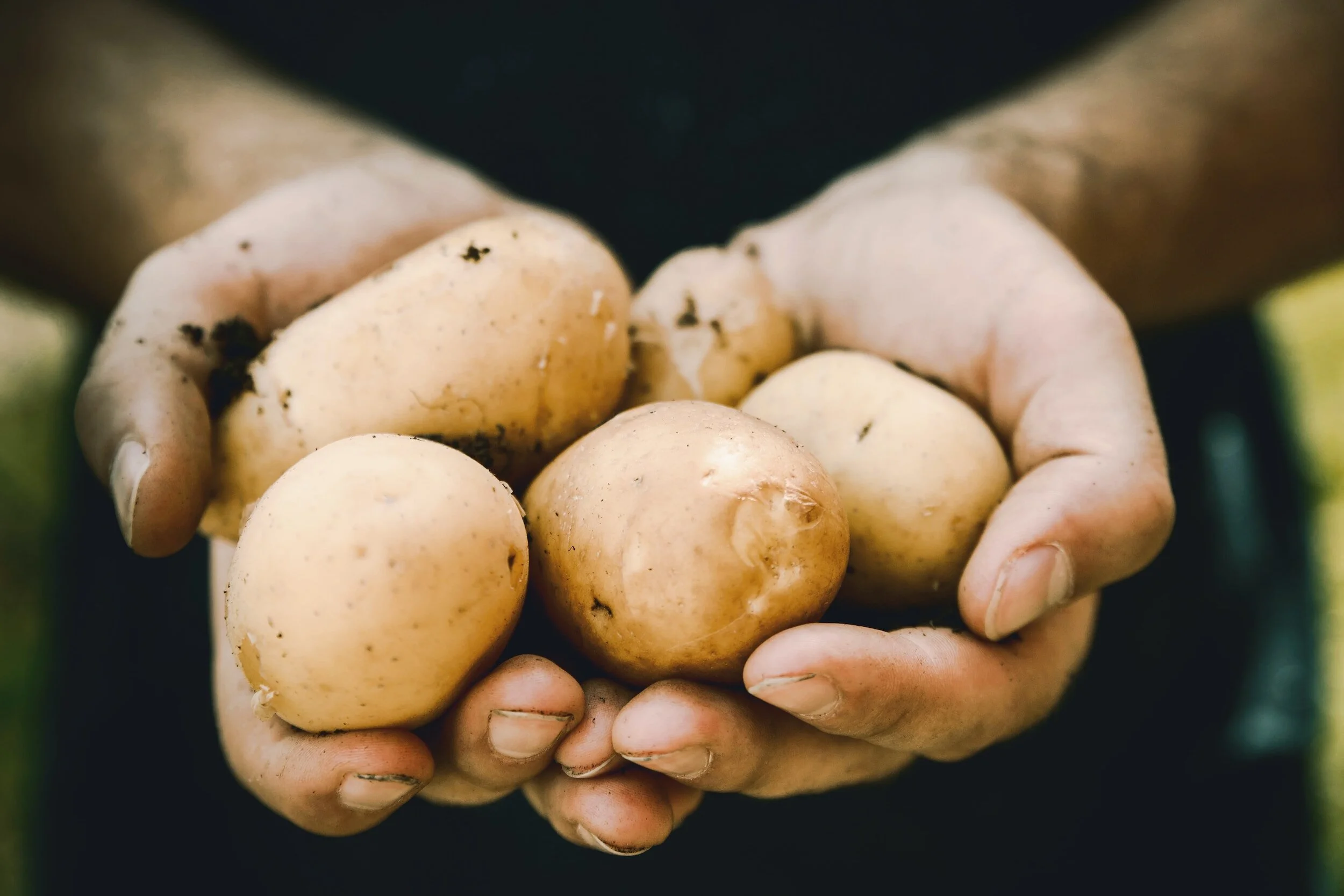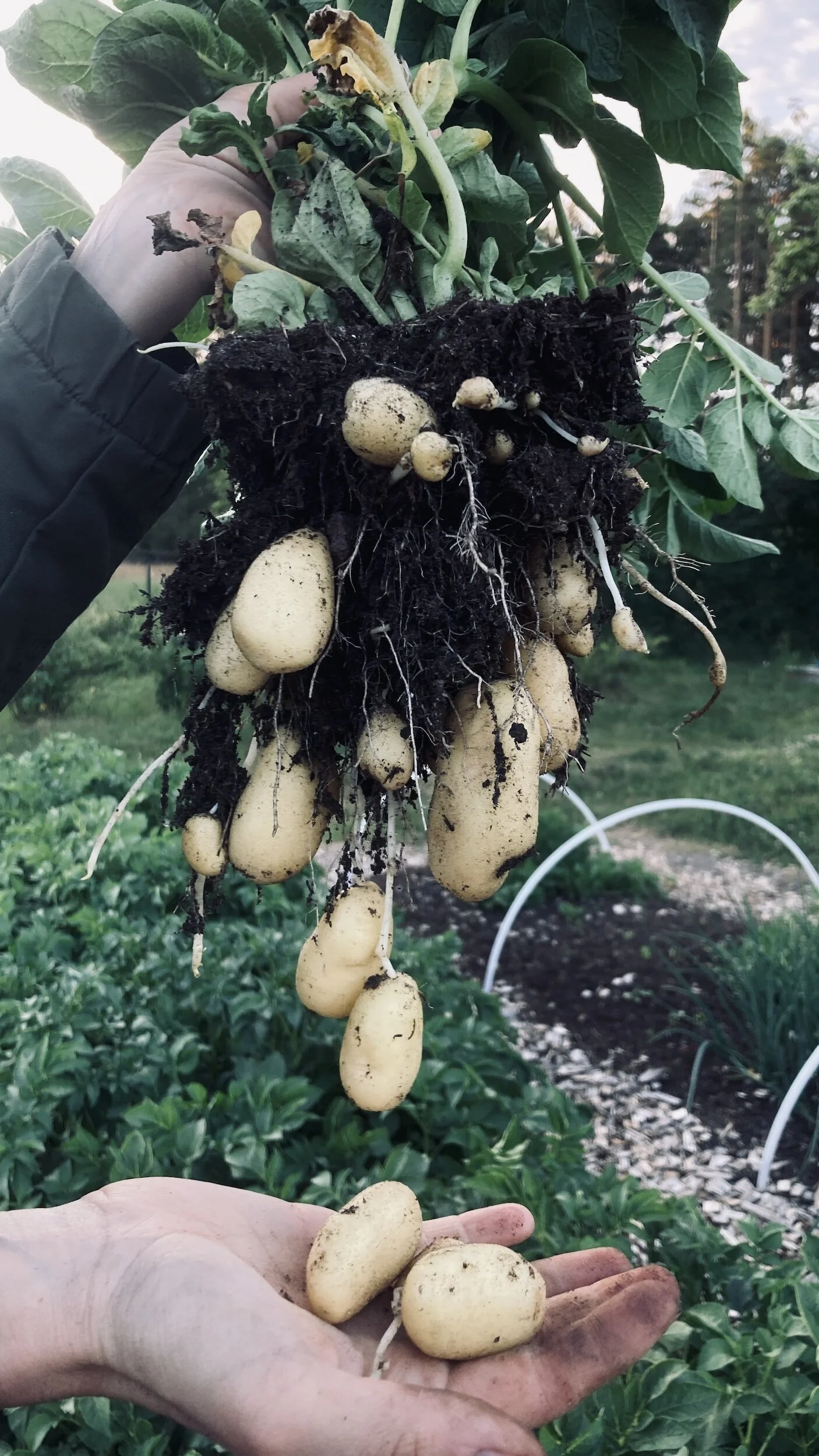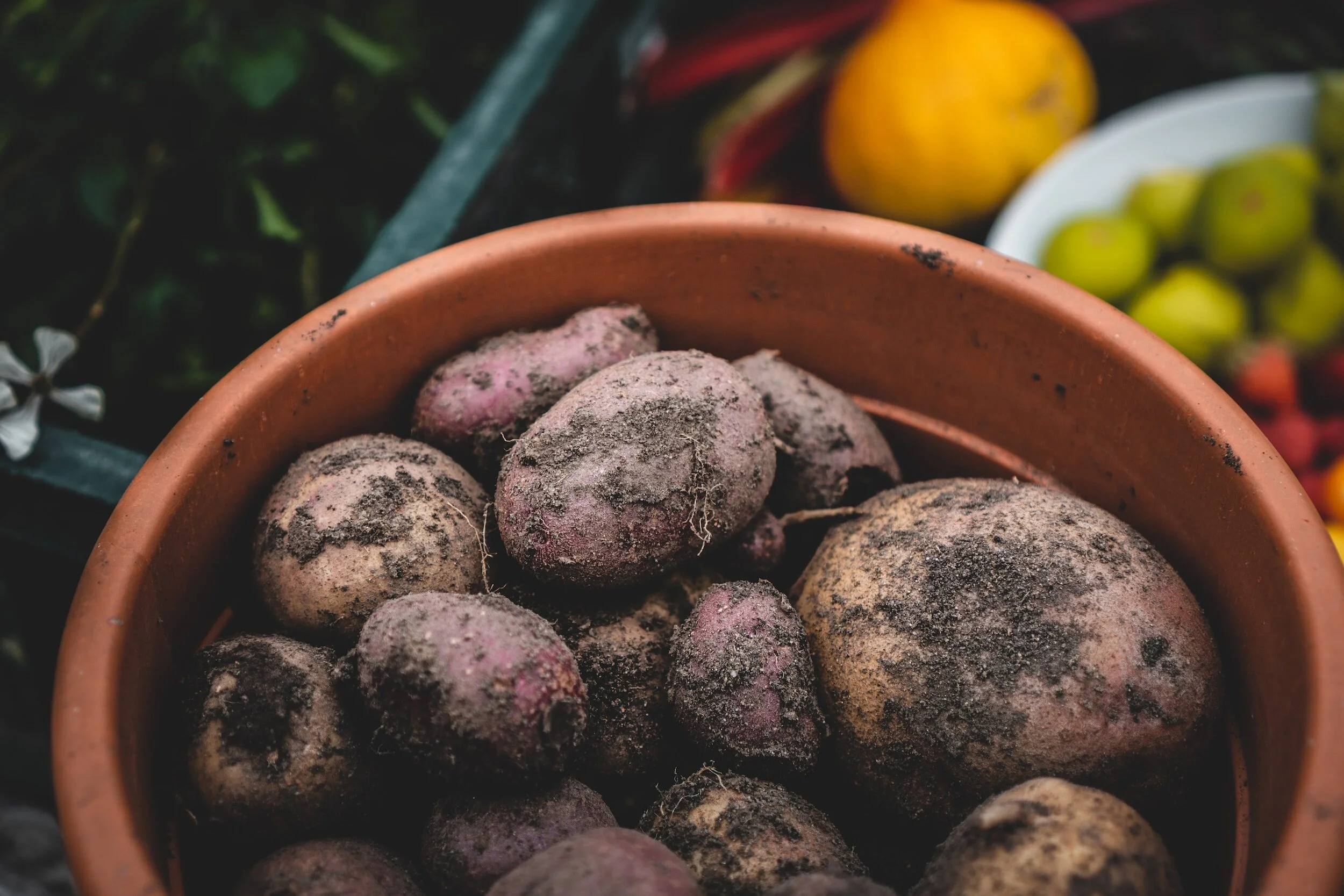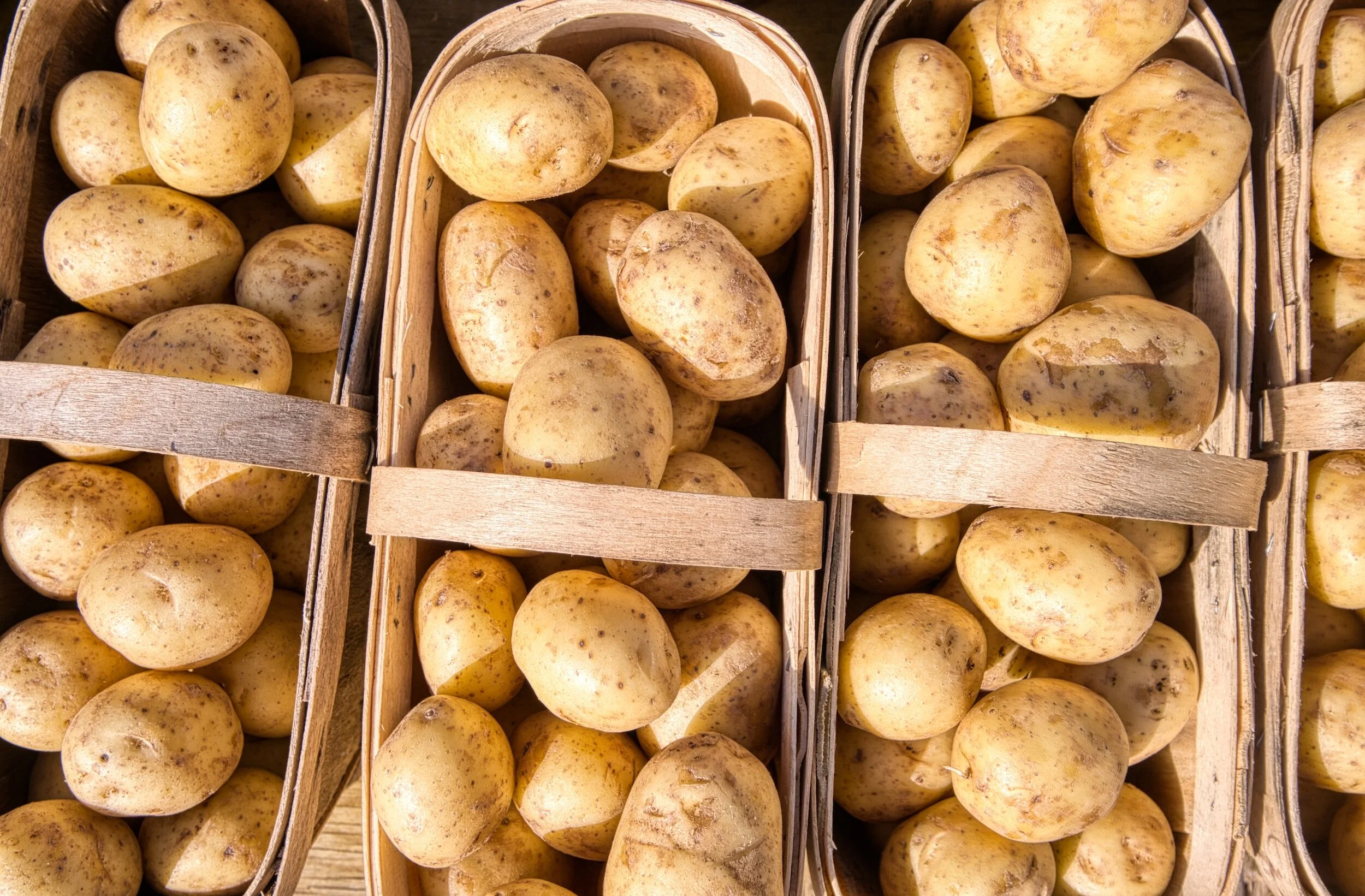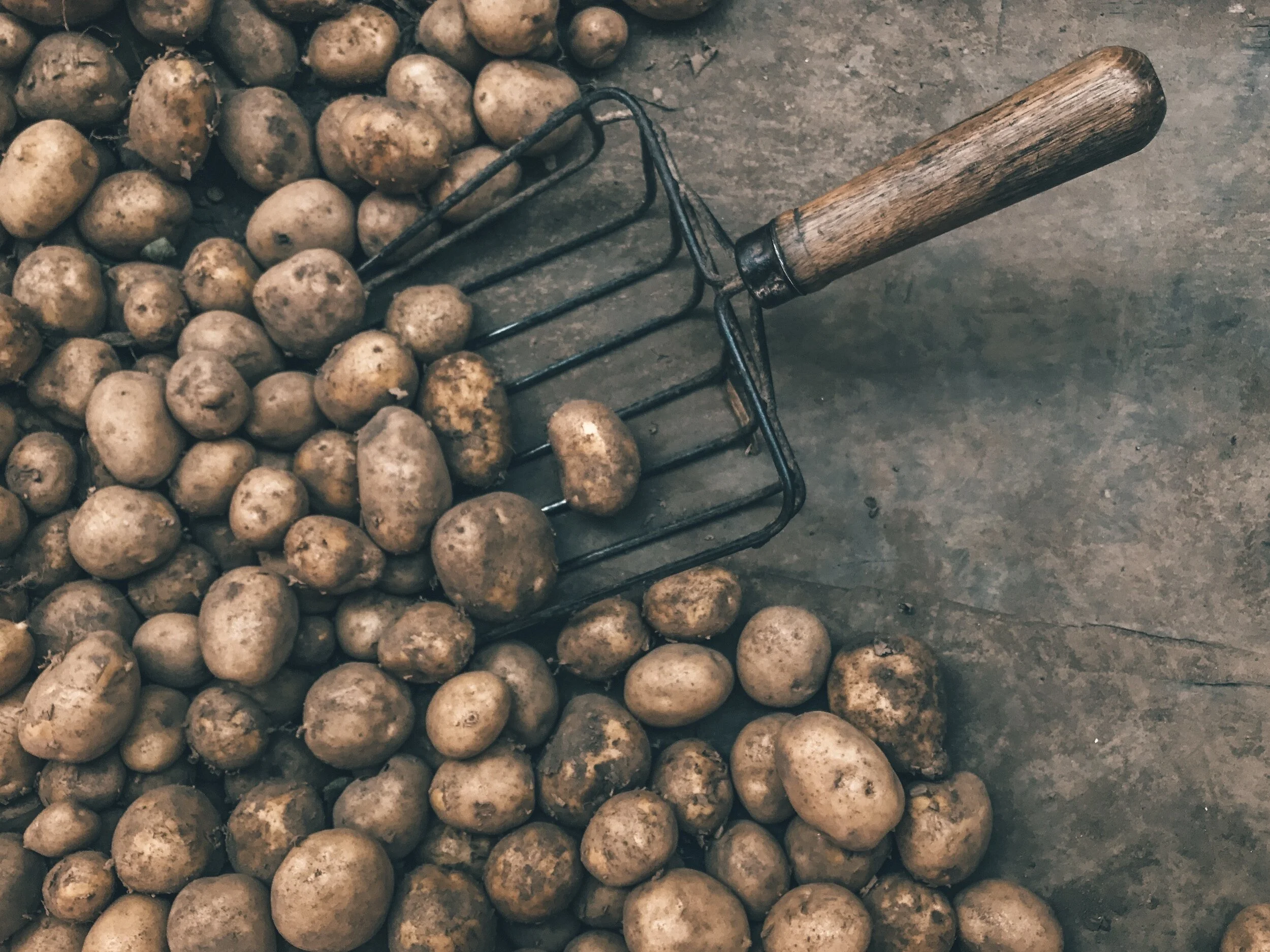How Long Do Potatoes Take to Grow?
This article has links to products that I may make commission from.
Potatoes are a staple in many households around the world. Whether mashed, baked, or fried, they're a versatile vegetable that I love.
But have you ever wondered how long it takes for potatoes to grow?
Or perhaps you're interested in trying your hand at growing them at home? Let's dive into the journey of the potato, from seed to harvest.
The time it takes for potatoes to grow can vary based on the variety and conditions. Typically, many potato plants will be ready for harvest in about 100 days.
Potatoes, being an underground tuber, have a growth pattern that might seem mysterious, but understanding their timeline can be both fascinating and crucial if you're thinking of planting them in your garden.
To learn more about potatoes, check out my guides:
Germination and Initial Growth (7-21 days post-planting)
After planting the seed potatoes in the soil, the first sign of life you'll notice is the sprouting of stems and leaves above the ground.
This germination process usually begins within a week or two of planting.
The exact timing can vary based on soil temperature, as potatoes prefer slightly cool conditions.
Vegetative Growth and Tuber Initiation (30-60 days post-planting)
Once the potato plant establishes itself with a robust above-ground presence, the magic starts happening beneath the soil.
The plant focuses on producing stolons, which are horizontal stems growing beneath the surface.
These stolons eventually swell and start forming tubers. By the end of this phase, small potato tubers begin to form.
Tuber Bulking (60-90 days post-planting)
This phase is all about the growth of those tubers.
The plant redirects most of its energy and nutrients from the leaves and stems to the growing tubers.
By the end of this stage, if you were to dig around the base of your potato plants, you'd find well-formed, though not fully matured, potatoes.
Maturation (90-120 days post-planting)
The final phase is where the potato plant begins to yellow and wither.
While this may seem alarming, it's entirely natural.
It's the plant's way of indicating that the tubers below are reaching maturity.
New potatoes can be harvested slightly earlier in this phase, but for fully matured potatoes, you'd wait until the plant has almost entirely died back.
Factors Influencing Growth Duration
While the above timeline gives a general idea, the exact duration can vary based on:
Potato Varieties:
Some varieties, like 'early' potatoes, mature faster than 'maincrop' ones. See list below of my recommended potato varieties.
Growing Conditions:
Soil quality, sunlight, and water all play a role. For instance, the Yukon Gold variety prefers well-drained soil and consistent moisture.
Planting Method:
Whether you're growing them in-ground, in a bucket, or in containers can influence growth time.
Understanding the Potato Planting Season
The cycle of a potato plant, from the planting of the seed potatoes to the moment of harvest, is closely entwined with the rhythms of the seasons.
Timing is pivotal, and understanding the planting season can mean the difference between a hearty harvest and disappointment.
1. Tuning into the Last Frost Date
Central to the potato planting schedule is the last frost date.
Potatoes are tubers that grow underground, and their early growth is vulnerable to hard frosts, which can impede or even kill emerging shoots.
This is why gardeners often mark their calendars with the last expected frost date.
However, rather than waiting for this date, planting can begin as soon as 2-4 weeks before, ensuring the ground is workable and not frozen.
2. The Soil’s Temperature and Texture
Beyond just the air's chill, the ground's warmth is a more telling sign of when to start planting.
A soil temperature of about 45°F (7°C) is ideal. It's neither too cold to stagnate growth nor too warm to cause the tubers to rot.
Equally important is the soil’s texture. Overly wet or waterlogged soil can cause seed potatoes to rot.
A well-draining soil, neither too sandy nor too clayey, can set the stage for a bountiful harvest.
4. Microclimates and Regional Nuances
It’s not just about the broad strokes of the season. Different regions have their own unique climates.
While someone in a warmer southern region might plant in late winter for an early spring harvest, if you are in a chillier northern zone you might have to hold off until late spring.
5. Day Length Considerations
Potatoes are day-sensitive. Their tuber formation is closely related to the length of the day.
In general, potato tubers begin to form when daylight lasts between 13 and 14 hours.
Thus, understanding how this daylight period aligns with the potato's growth phase can further refine your planting schedule.
Check out my guide: The Secret Life of Potato Flowers.
Choosing the Right Potato Varieties
The world of potatoes is vast and diverse, boasting a rainbow of colors, textures, and flavors.
When considering which potato varieties to plant, it's essential to consider not only your personal preferences but also your growing conditions and intended use.
Here's my guide to help you make an informed choice:
1. Early, Mid, and Late Season Varieties
Potatoes are typically categorized based on their maturity timeline:
Early Season Potatoes:
These are the sprinters of the potato world, maturing in about 70-90 days.
Varieties like 'Red Norland' are the best for those eager for an early harvest.
Here are the ‘Red Norland’ seed potatoes I recommend:
Mid-Season Potatoes:
These take a moderate amount of time, maturing in around 100 days.
Examples include the much-loved ‘Yukon Gold’ and 'Kennebec'.
Here are the ‘Yukon Gold’ seed potatoes I recommend:
Late Season Potatoes:
Requiring patience with a maturation period of 120-135 days, varieties like 'Russet Burbank' are worth the wait, often yielding larger tubers.
Here are the ‘Russet Burbank’ seed potatoes I recommend:
2. Culinary Use
Different potatoes have varying starch contents, influencing their culinary characteristics:
Waxy Potatoes:
These have a lower starch content, resulting in a firmer texture.
They hold their shape well, making them perfect for salads and boiling. The best variety is 'Red Pontiac'.
Here is the ‘Red Pontiac’ seed potatoes I recommend planting:
Floury Potatoes:
High in starch, these potatoes are fluffy when cooked. They're ideal for mashing, baking, and frying.
'Russet' is the best choice. Here are the seed potatoes I recommend:
All-Purpose Potatoes:
Sitting in between, these varieties can be used in a range of dishes. Yukon Gold is a standout all-purpose potato.
3. Climate and Soil Suitability
While potatoes are versatile, different varieties might prefer specific conditions:
Cool Climates:
Varieties like 'Russet' thrive in cooler conditions, with mild summers.
Warm Climates:
'Red Pontiac' and 'Yukon Gold' can tolerate a bit more heat and are suitable for regions with warmer summers.
Soil Preferences:
While most potatoes prefer well-draining soil, some are more tolerant of heavy or clayey soils than others. It's essential to match the variety to your garden's soil type.
4. Aesthetic and Nutritional Choices
Beyond the practicalities, potatoes offer a palette of colors, from the standard brown and yellow to red, purple, and even blue.
Varieties like 'Purple Majesty' or 'Adirondack Blue' not only add a splash of color to your plate but also come packed with antioxidants.
Here are the ‘Purple Majesty’ seed potatoes I recommend:
Here are the ‘Adirondack Blue’ seed potatoes I recommend:
The Potato Planting Process
Planting potatoes isn't just about burying them in the ground and waiting for a harvest.
There's an art and science to it, ensuring that the tubers get the best start possible.
Here’s a step-by-step guide to help demystify the process:
1. Sourcing Seed Potatoes
The journey starts with choosing the right seed potatoes. It's essential to source certified disease-free seed potatoes from reputable suppliers.
While it might be tempting to plant tubers from the grocery store, these might not be disease-free and could have been treated to prevent sprouting.
2. Chitting or Pre-Sprouting
Before they even touch the soil, it's beneficial to let your seed potatoes sprout a bit.
Place them in a bright, cool location (around 50°F or 10°C) with the 'eyes' facing upwards.
This process, known as chitting, helps in developing strong sprouts, giving the potatoes a head start when planted.
3. Preparing the Soil
Potatoes love well-draining soil. Ensure your garden bed is loose and aerated.
A blend of garden soil, compost, and a bit of sand can create an ideal environment.
Remember, potatoes are slightly acidic lovers, so a pH of 5.0 to 6.5 is optimal.
4. Planting Depth and Spacing
How deep you plant can influence your harvest:
Planting Depth:
Generally, you'd want to plant seed potatoes about 3-4 inches deep.
Ensure the sprouts are facing upwards.
Spacing:
Give each potato enough room to grow.
Space them about 12 inches apart in rows, with each row being about 30 inches apart.
5. Hilling
As your potato plants grow, it’s crucial to keep mounding or "hilling" soil around the base.
This process prevents the tubers from being exposed to sunlight, which can turn them green and toxic.
Hilling also provides the growing tubers with more room. Start the process when plants are about 6 inches tall and continue as they grow.
6. Watering and Care
Potatoes need consistent moisture, especially during the tuber formation phase.
However, they don't like to sit in waterlogged soil. Ensure you water them consistently but avoid overwatering, which can lead to rot.
7. Watch Out for Pests and Diseases
From the Colorado potato beetle to the dreaded potato blight, being vigilant can save your crop.
Regularly inspect your plants, remove any pests manually, and use organic preventative measures as needed.
Growing Potatoes in Conatiners and Buckets
You don't necessarily need a vast garden space to grow potatoes. How long it takes to grow potatoes in a bucket or container can be slightly different than in-ground, but it's certainly feasible.
It's essential to ensure proper drainage and adequate soil depth when growing potatoes in a container.
Choosing the Right Container
Buckets:
5-gallon buckets are popular. Ensure they've not been used to store toxic materials. Also make sure to drill proper drainage holes at the bottom of the bucket.
Here is the bucket I recommend:
Grow Bags:
Grow bags designed for potatoes offer excellent drainage and are easy to store.
Here is the grow bag I recommend:
Large Planters:
Anything deep and spacious can work, from wooden crates to specialized potato tubs.
Here is the potato tub I recommend:
Regardless of choice, ensure there's adequate drainage. Drill or puncture holes if necessary.
Soil and Fertilizer
Potatoes in containers thrive in a loose, well-draining mix:
Potting Mix:
Avoid garden soil which can be too dense. Learn more about this in my guide Garden Soil vs. Potting Soil: How to Choose the Right One.
Opt for a high-quality organic potting mix, possibly with added compost for nutrients.
Here is the organic potting mix I recommend:
Fertilizer:
Potatoes are hungry plants. Use a slow-release fertilizer or consider supplementing with organic options like seaweed extract.
Here is the potato fertilizer I recommend:
Planting in Containers
The process is similar to traditional planting but with some tweaks:
Layering:
Start by adding about 6 inches of soil to your container.
Place 2-4 seed potatoes (depending on container size) with sprouts facing up.
Cover with another 6 inches of soil.
Spacing:
If you're using larger containers, ensure seed potatoes are at least 5 inches apart.
Care, Watering, and Hilling
Container potatoes have specific needs:
Watering:
Containers dry out faster, so regular watering is crucial.
Ensure the soil remains moist but not waterlogged.
Hilling:
As shoots grow, continue adding soil or compost, leaving just the top few inches of the plant exposed.
This process, called hilling, encourages more potato growth and prevents sun exposure.
Harvesting from Containers
One of the joys of container growing is the ease of harvest.
For new potatoes, feel around in the top layer of soil.
For a full harvest, once the foliage has died back, simply tip over the container and sift through the soil to collect your bounty.
Want to learn more about growing vegetables in containers? Check out my guides:
Harvesting and Storing
Harvesting is arguably the most rewarding part of growing potatoes, but it’s what you do after the harvest that ensures you get to enjoy your potatoes for months to come.
Proper harvesting techniques combined with optimal storage conditions can significantly extend the life of your potatoes.
When to Harvest
New Potatoes:
These are the young, tender potatoes that are harvested early.
You can begin harvesting new potatoes a few weeks after plants have finished flowering.
Gently dig around the base of the plants to retrieve them, but leave the main plant undisturbed to continue growing.
Mature Potatoes:
These are harvested when the plants have died back and turned yellow or brown.
This typically occurs about 2-4 weeks after flowering, depending on the variety.
How long do potatoes take to grow to maturity? Generally, early varieties take around 70-90 days, mid-season around 100 days, and late-season varieties can take 120-135 days.
How to Harvest
Be Gentle:
Use a spading fork to carefully loosen the soil around the potato plant.
Ensure you start digging from a distance to avoid piercing the tubers.
Avoid Sun Exposure:
Once unearthed, potatoes should not be left in direct sunlight for long.
Excessive sunlight can turn them green, which indicates the presence of solanine, a toxic compound.
Curing Your Harvest
Curing is a process of allowing the potato skins to harden, which aids in longer storage. After harvesting:
Spread Out:
Lay out your potatoes in a well-ventilated, dark, and cool place. A garage or shed often works well.
Let Them Be:
Allow them to cure for about 10-14 days. This process helps minor cuts or bruises heal and thickens the skin.
Storing Potatoes
Proper storage is crucial for the longevity of your harvest.
Ideal Conditions:
Store potatoes in a cool, dark, and humid place.
The optimal temperature range is between 45°F to 50°F (7°C to 10°C).
Avoid storing potatoes in the refrigerator, as cold temperatures can convert starches into sugars, altering their taste and texture.
Container:
Use a wooden box, basket, or even a paper bag. Ensure there's adequate ventilation.
Do not use plastic bags, as they can promote mold and rot.
Separate from Apples and Onions:
Both release gases that can spoil potatoes faster.
Inspect Regularly:
Check on your stored potatoes and remove any that show signs of rotting or sprouting.
Do Not Store Damaged Potatoes
Any potatoes that are bruised, cut, or punctured should be used soon after harvesting.
These will not store well and can lead to spoilage of other tubers if kept together.
FAQs
How long do potatoes take to grow in the ground?
Typically around 100 days, but it can vary based on the variety and conditions.
How long do potatoes take to grow from seed?
Seed potatoes are not true seeds. They are small potato tubers used for planting. From planting these tubers, it generally takes about 100 days for most varieties to mature.
How long does it take to grow potatoes in a bucket?
It usually takes the same time as in-ground, around 100 days, provided they get proper care and optimal conditions.
How to grow potatoes in a container?
Ensure a deep container, proper drainage, and nutrient-rich soil. Place seed potatoes in, cover, and ensure they receive adequate sunlight and water.
When to plant potatoes?
This is determined by the last frost date in your area. Planting usually occurs in early spring.
